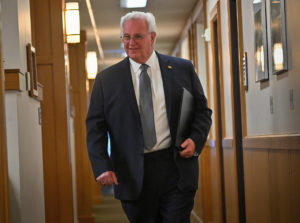
By PETER WONG/Oregon Capital Bureau
A Democrat from the Oregon coast and a Republican from southern Oregon are teaming up to devise a way for smaller communities to draw state money for the water and sewer lines and other infrastructure needed to construct more housing.
Reps. David Gomberg, D-Otis, and Emily McIntire, R-Eagle Point have so far offered few details of the proposal they are planning for the 2024 legislative session, which starts its 35-day run on Feb. 5.
But Gomberg did confirm that their work dovetails with Gov. Tina Kotek’s proposed $500 million to jump-start housing production. Kotek disclosed details of her proposed spending on Jan. 17, a few days after Gomberg and McIntire spoke to a House committee on Jan. 11.
Kotek has proposed $200 million for communities to tap for expanded public works, although she apparently is leaving to lawmakers how it should be distributed.
Both Gomberg and McIntire mentioned numerous examples of communities they represent that need upgrades or expansions of public works.

“As we look across the state, we see municipalities and districts that are struggling with infrastructure that is aging, or at capacity — or they have a desire to expand and create those new homes, but do not have the capacity to service that expansion, said Gomberg. “I will sum it up this way: Small towns cannot afford to pay for big projects.”
In his weekly email to constituents on Monday, Gomberg said while Oregon needs more housing “… we need water and sewer to support it.”
“And across Oregon, too many local systems are failing, at capacity, or unable to support new connections,” he wrote. “Improvements and expansion are expensive. And too often small towns can’t afford the cost of big projects. I often point to the city of Siletz with 1,100 residents and a $12 million sewer problem. Dozens and actually hundreds of communities across the state are in similar circumstances.”
Gomberg said he and his staff have been working with the legislative Joint Water Caucus to develop a list of critical water and sewer proposals, reached out to the League of Oregon Cities, the Association of Oregon Counties, the Special Districts Association, and to other legislators.
“We now have a list of nearly 300 proposals in hand,” he said, adding that staff is working on a way to evaluate projects and funding.
“Who is ready to go now? Who has invested local funds rather than just asking for state support,” Gomberg wrote. “Where will state investments have the most effect? Where is the situation most critical?”
A better way to help?
McIntire said that a local school district in Southern Oregon sought recent approval of a $60 million bond issue, but voters rejected it by 70 percent.
“Going out for a bond in these small communities is impossible,” she said. “Really, it comes to us for help for these small towns.”
State government does have some grant programs for communities and districts. The Oregon Business Development Department oversees the special public works fund, which relies on legislative approval of Oregon Lottery proceeds in the state’s two-year budget cycle. The state also has a program that helps school construction — although grants are forthcoming only if district voters approve their share.
The Legislature also can set aside money for community projects in the budget reconciliation bill passed at the end of a session — sometimes known as the “Christmas tree bill” — but Gomberg said he’d rather see a more systematic way for the state to deal with local requests. Even communities whose projects are funded directly by the Legislature often wait 12 to 18 months to get their money while contracts are made final.
Gomberg is the House’s co-leader of one of the Legislature’s budget subcommittees.
Gomberg said he is not under the illusion that whatever lawmakers decide in the 2024 session is going to give all small communities the state aid they need for public works. He said more than 80 communities have expressed interest already.
“What we are trying to do is address needs that are our highest priorities — right now — in a bipartisan way across the state,” Gomberg said.
“I will say this is the next step, not the first step,” he added. “It’s going to be hard to say: Here are the projects we can pay for with the money we got right now. We want to create a solution and a process. We want to create a methodology to help us decide who is next in line.”
- Peter Wong covers state government for Pamplin Media Group; YachatsNews contributed to this report.



